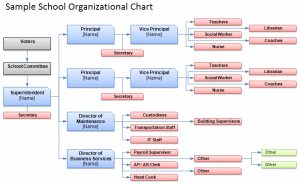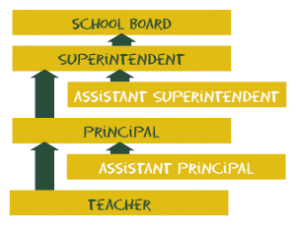K-12 Administration
SCHOOL DISTRICT STRUCTURE
A school district has a hierarchical structure of educational administrators responsible for academic success in a specific region. The different levels of responsibility funnel from the state level to specific schools. This pyramid structure ensures that all educators are committed to the same goals which are defined by the state.
The superintendent of schools reports directly to the state board of education. This management role may oversee one or more school districts and is responsible for enforcing state education policy at the district level. The superintendent directly (or indirectly) supervises every employee and administrator in his district. A superintendent of schools attends board meetings, prepares budgets for board review and facilitates implementation of policy at the school level. Large districts may also have an assistant or deputy superintendent.
Executive Director
Executive directors are responsible for a specific aspect of the school system in their district. Divisions may be split by grade level (elementary and high school) or school location. Some executive directors oversee schools while others oversee programs or administrative needs, such as maintenance or human resources. The executive directors, who are sometimes known as associate superintendents, report to the superintendent of schools.
Principals
Each school has a principal whose role is to manage the school on a day-to-day basis. The principal reports to his respective executive director, and also works closely with the teachers and students in his school to support the goals of the board of education and ensure that the school adheres to the outlined curriculum. The principal monitors the academic performance of his school and implements programs to boost performance if necessary. The principal is also responsible for student discipline, event scheduling, budget proposals and community relations. An assistant principal often assists with delegated duties.
Teacher
A school teacher works directly with students to support goals outlined by the Board of Education. They prepare lesson plans that adhere to the curriculum designed by the board, and they also administer standardized tests. In addition, teachers meet with students and parents to discuss academic progress and offer additional assistance when needed. Teachers usually report to the school principal, but may report to a lead teacher for their specific discipline.
Organizational Structure of Schools
By Scott Wolfenden
A school’s organizational structure can affect the teacher’s attitude and teaching style. Schools can have several types of organizational structures. Some of these structural frameworks include traditional or bureaucratic, loosely coupled systems and interdisciplinary team organization (ITO). The structure of the school can affect teachers’ attitudes towards teaching and work satisfaction, as well as the graduation rate of the students. 
Bureaucratic Model
A traditional or bureaucratic school structure focuses on a top-down approach. Decision-making starts at the top with the policies of the school district and works its way down to principals and finally to teachers. It is highly structured, and the teacher’s role in decision-making is limited.
Loosely Coupled Systems
In a loosely coupled organizational structure, teachers have a great deal of autonomy. However, there may not be much goal setting on the part of the school or fluidity between departments.
Interdisciplinary Team Organization (ITO)
In an interdisciplinary team organization (ITO) structure, teachers from two or more fields have a common planning period and work as a team with a shared body of students. This form of structure is most commonly used in middle schools, but is also sometimes used in high schools. Interdependent collaboration can have a beneficial effect on teacher morale and the quality of presentation.
Effects
A study conducted by researchers from the University of Hawaii and published in the “American Journal of Education” concluded that a school’s structure could measurably affect student


Recent Comments